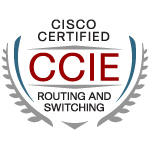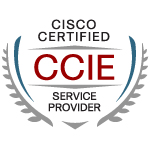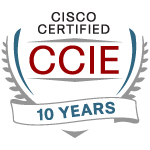CCDP Course + Exam Details
CCDP Certification
A Cisco Certified Design Professional (CCDP) can discuss, design, and create advanced addressing and routing, security, network management, data center, and IP multicast complex multi-layered enterprise architectures that include virtual private networking and wireless domains. With Logitrain you can ensure your success in professional career, as Logitrain has acquired certified and professional trainers.
CCDA certification is a pre-reqisite for Cisco Certified Design Professional (CCDP) certification.
The CCDP certification course covers various concepts such as implementing Scalable Routing Protocols, extending IP addresses – VLSM, describing OSPF in a Single Area, interconnect Multiple OSPF Areas, describing and configuring Enhanced IGRP, describing and configuring IS-IS, operating a Network Using Multiple Routing Protocols, optimising Routing Updates Operation, configuring DHCP, configuring Basic Border Gateway Protocol (BGP),
configuring Layer 3 Redundancy with HSRP and VRRP, implementing Wireless LANs, Wireless LAN Technology and Standards, configuring Switches to Support Voice over IP, understanding the Switch Security Issues and what not.
- Training: get practical technical skills
- Receive a certificate of course attendance
- Small class size: increased instructor interaction
- Authorised test centre: exams taken at our premises
- More hands-on: 6 weeks remote lab access included
- Expert trainers: imparting real world experience
CCDA Training
Candidates can achieve this certification by passing the following exam(s).
- Implementing Cisco IP Routing (ROUTE) – Exam 300-101
- Implementing Cisco IP Switched Networks (SWITCH) – Exam 300-115
- Designing Cisco Network Service Architecture (ARCH) – Exam 300-320
The certification exam can be registered and attempted within 3 months of course/module completion at Logitrain training centre on weekdays during normal business hours (excludes public holidays)
- Ciscopress: CCNP ROUTE Official Certification Guide
- Ciscopress: CCNP SWITCH Official Certification Guide
- Ciscopress: CCDP ARCH Official Certification Guide
- Implement Scalable Routing Protocols
- Extend IP addresses – VLSM
- Describe OSPF in a Single Area
- Interconnect Multiple OSPF Areas
- Describe and Configure Enhanced IGRP
- Describe and Configure IS-IS
- Operate a Network Using Multiple Routing Protocols
- Optimize Routing Updates Operation
- Cisco IOS Features: Configure DHCP
- Configure Basic Border Gateway Protocol (BGP)
- Implement BGP In Scalable Networks
- Implement IP Multicasting
- Implement IPv6
- Overview of the Campus Network
- Configure VLANS and VTP
- Implement Spanning Tree Protocol (STP)
- Implement Rapid Spanning Tree Protocol (RSTP)
- Implement Multiple Instance of Spanning Tree Protocol
- Implement STP Security Mechanisms
- Implement Multilayer Switching
- Configure Layer 3 Redundancy with HSRP and VRRP
- Implement Wireless LANs
- Wireless LAN Technology and Standards
- Configure Switches to Support Voice over IP
- Understand Switch Security Issues
- Design advanced core enterprise networks
- Design campus Infrastructure using best practices
- Design a High Availability enterprise network
- Design a high availability WAN
- Design network management services
- Design IP multicast services
- Describe enterprise VoWLAN design considerations
- Design an enterprise data center
- Design a high availability data center network that is modular, flexible and meets standards
- Describe the components and technologies of a SAN network
- Design an effective E-Commerce module
- Design security services
This course is likely to add to the employment related skills of the participants. The skills developed are likely to be used in the course of being an employee or working in a business.
- Design engineers
- Network consultants
- System engineers
- Individuals seeking CCDP and CCDE certification
Key Topics: Implementing Cisco IP Routing – ROUTE (300-101)
- Determine network resources needed for implementing EIGRP in a network
- Create an EIGRP implementation plan
- Create an EIGRP verification plan
- Configure EIGRP routing
- Verify an EIGRP solution was implemented properly using show and debug commands
- Document the verification results for an EIGRP implementation
- Determine network resources needed for implementing OSPF on a network
- Create an OSPF implementation plan
- Create an OSPF verification plan
- Configure OSPF routing
- Verify OSPF solution was implemented properly using show and debug commands
- Document the verification results for an OSPF implementation plan
- Determine network resources needed for implementing eBGP on a network
- Create an eBGP implementation plan
- Create an eBGP verification plan
- Configure eBGP routing
- Verify eBGP solution was implemented properly using show and debug commands
- Document verification results for an eBGP implementation plan
- Determine network resources needed for implementing IPv6 on a network
- Create an IPv6 implementation plan
- Create an IPv6 verification plan
- Configure IPv6 routing
- Configure IPv6 interoperation with IPv4
- Verify IPv6 solution was implemented properly using show and debug commands
- Document verification results for an IPv6 implementation plan
- Create a redistribution implementation plan based upon the results from a redistribution analysis
- Create a redistribution verification plan
- Configure a redistribution solution
- Verify that a redistribution was implemented
- Document results of a redistribution implementation and verification plan
- Identify the differences between implementing an IPv4 and IPv6 redistribution solution
- Create a Layer 3 path control implementation plan based upon the results of the redistribution analysis
- Create a Layer 3 path control verification plan
- Configure Layer 3 path control
- Verify that a Layer 3 path control was implemented
- Document results of a Layer 3 path control implementation and verification plan
- Implement basic teleworker and branch services
- Describe broadband technologies
- Configure basic broadband connections
- Describe basic VPN technologies
- Configure GRE
- Describe branch access technologies
Key Topics: Implementing Cisco IP Switched Networks – SWITCH 300-115)
- Create a VLAN based verification plan
- Configure switch-to-switch connectivity for the VLAN based solution
- Configure loop prevention for the VLAN based solution
- Configure Access Ports for the VLAN based solution
- Verify the VLAN based solution was implemented properly using show and debug commands
- Document the verification after implementing a VLAN solution
- Determine network resources needed for implementing a Security solution
- Create a implementation plan for the Security solution
- Create a verification plan for the Security solution
- Configure port security features
- Configure general switch security features
- Configure private VLANs
- Configure VACL and PACL
- Verify the Security based solution was implemented properly using show and debug commands
- Document the verification results after implementing a Security solution
- Determine network resources needed for implementing a Switch based Layer 3 solution
- Create an implementation plan for the Switch based Layer 3 solution
- Create a verification plan for the Switch based Layer 3 solution
- Configure routing interfaces
- Configure Layer 3 Security
- Verify the Switch based Layer 3 solution was implemented properly using show and debug commands
- Document the verification results after implementing a Switch based Layer 3 solution
- Implement a Wireless Extension of a Layer 2 solution
- Implement a VoIP support solution
- Implement video support solution
- Determine network resources needed for implementing High Availability on a network
- Create a High Availability implementation plan
- Create a High Availability verification plan
- Implement first hop redundancy protocols
- Implement switch supervisor redundancy
- Verify High Availability solution was implemented properly using show and debug commands
- Document results of High Availability implementation and verification
Key Topics: Designing Cisco Network Service Architecture – ARCH (300-320)
- Identify the major desktop components and interfaces and their functions
- Differentiate the characteristics of Windows 9x/Me, Windows NT 4.0 Workstation, Windows 2000 Professional and Windows XP
- Identify the names, locations, purposes and contents of major system files
- Demonstrate the ability to use command-line functions and utilities to manage the operating system, including the proper syntax and switches
- Identify basic concepts and procedures for creating, viewing, and managing disks, directories and files
- Identify the major operating system utilities, their purpose, location and available switches
- Identify the procedures for installing Windows 9x/Me, Windows NT 4.0 Workstation, Windows 2000 Professional and Windows XP
- Identify steps to perform an operating system upgrade from Windows 9.x/ME, Windows NT 4.0 Workstation, Windows 2000 Professional and Windows XP
- Identify procedures for installing/adding a device, including loading, adding, and configuring device drivers and required software
- Identify procedures necessary to optimize the operating system and major operating system subsystems
- Recognize and interpret the meaning of common error codes and startup messages from the boot sequence and identify steps to correct the problems
- Recognize when to use common diagnostic utilities and tools. Given a diagnostic scenario involving one of these utilities or tools, select the appropriate steps needed to resolve the problem
- Recognize common operational and usability problems and determine how to resolve them
- Identify the networking capabilities of Windows. Given configuration parameters, configure the operating system to connect to a network
- Identify the basic Internet protocols and terminologies
- Identify procedures for establishing Internet connectivity. In a given scenario, configure the operating system to connect to and use Internet resources
“We have helped thousands achieve Cisco Certifications, let us help you”
– Murad Tanvir, Double CCIE #17081
Founder and CEO Logitrain

Includes Official Exam Fee
Take the certification exam within 3 months of course / module completion

100% Money Back Guarantee
Training fee is fully refundable if you are not satisfied with the training

Includes Course Material
Course material in hardcopy is included for you to keep for reference and support

Includes Practise Questions
Practise questions are included to assist you in preparing for the official exam

Highly Skilled Trainers
Our trainers are highly skilled with expertise and extensive hands-on experience

Our Price Beat Guarantee
Relax, we will beat competitor’s advertised price. Our course has no extra costs
| Location | Type | Duration | Price | Dates | |
|---|---|---|---|---|---|
| Location | Type | Duration | Price | Dates |















Accreditations
OUR SATISFIED CUSTOMERS
| Approachable and knowledgeable; comfortable surroundings. Logitrain does make IT training easier |
I recently followed the ITIL Foundation course at Logitrain. The training, materials and facilities were excellent and I would not hesitate to train with Logitrain again.
Thanks for a great week! Really enjoyed and feel I picked up a lot. Great Trainer! Will definitely look at further studies here.
Well-presented and able to convey immense knowledge to class. All queries were responded to promptly.
Excellent teaching method, easy to understand.
Logitrain provided a valuable insight into ITIL and enabled me to excel and advance my knowledge through a simple and well organised series of sessions.
Great place to study for certification, knowledgeable persons, excellent customer service. Ready to answer queries on the spot, very helpful.
The trainer was very patient and gave everybody the opportunity to participate.
The trainer explained everything very well. Logitrain was very helpful for me in getting a better overall understanding of CCNA. I previously had studied it 2 years earlier but required revision















